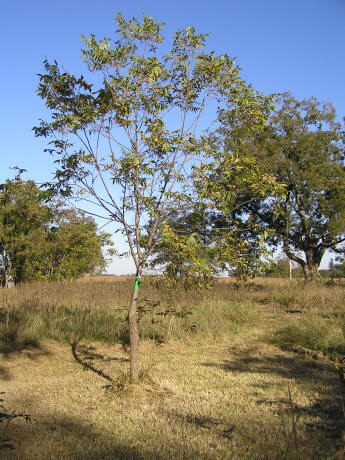Bill Devlin
Adams County Master Gardener
 Since 2002, I have written a number of articles on pecans, a particular interest of mine. The first was titled "Growing Pecan Trees in South
Central Pennsylvania", followed by a second in 2002, "Stratification of Seeds". Other pecan topics covered in the last several years were "Growing Nuts for Food and Fun", "Take 2 on
Stratification of Seeds - Necessary but not Sufficient", and "What to Do After the Beaver Comes", an article about a pecan tree attacked by a beaver.
Since 2002, I have written a number of articles on pecans, a particular interest of mine. The first was titled "Growing Pecan Trees in South
Central Pennsylvania", followed by a second in 2002, "Stratification of Seeds". Other pecan topics covered in the last several years were "Growing Nuts for Food and Fun", "Take 2 on
Stratification of Seeds - Necessary but not Sufficient", and "What to Do After the Beaver Comes", an article about a pecan tree attacked by a beaver.
Several times I have mentioned that growing pecans is not for the impatient, but rather for patient gardeners who long for the satisfaction of leaving something meaningful behind for others to enjoy. From time to time, I have offered stratified nuts and started pecan seedlings to interested readers.
This article is aimed to those who have taken me up on these offers or wish to do so in the future.
The situation is this: pecans do not grow true from a seedling, as most pecans have a parent tree bearing them but have a random second parent drawn literally from the winds of pollination. To get a desired variety, grafting is a must. For the nitty-gritty on grafting, I refer you to my pecan guru,
Dr. Bill Reid of Kansas State University and the University of Missouri. His article "Propagating Pecan and Black Walnut in Missouri" is recommended as a definitive work on the subject. You can read it on the internet at
http://www.centerforagroforestry.org/pubs/proppecbw.pdf.
Now to the subject of the title -- which variety to graft. And what do Kansas and Missouri have to do with south central Pennsylvania? The answer to the latter is that the southern parts of these states all share the same USDA climate zone, 6b. This means that the same trees will, given enough
moisture and lack of uncontrolled fire, grow well.
How does one learn about pecan varieties? The easiest way is to try this web site:http://extension-horticulture.tamu.edu/carya/ This is the Agriculture Research Service of the US Department of Agriculture. Next click on "Pecan Cultivar
Index", and then do an alphabetic search by cultivar name. You will find hundreds to choose from. Now what? Actually things are not as difficult as they might seem. My dear friend Dr. Reid of the Chetopa Experiment Station and Secretary-Treasurer of the Kansas Nut Growers Association has just released his "Pecan and Black
Walnut Scionwood 2009 Application", which lists 23 pecan varieties and 15 black walnut varieties of scionwood that are available at a reasonable price. In our area we are looking for "Northern" varieties, those that grow in zone 6, and not the varieties that are prevalent in Georgia, the Carolinas, Alabama, Mississippi and
southern Texas. Ones I have personal experience with include Pawnee, Maramec, Kanza, Chetopa, Giles, Posey and Peruque. A grove should include several varieties as cross pollination is a must for these pecans.
 My personal plan this year at my grove in Kansas is to concentrate on Kanza. We have several Pawnee in the Carroll Valley Lake Kay Park and I have them on my local farm. I am also trying a few Maramec as
they are a large "paper shell", i.e. easy shell to break. This type may be hurt by an early frost so I am doing them in a wind-protected clearing in deep woods.
My personal plan this year at my grove in Kansas is to concentrate on Kanza. We have several Pawnee in the Carroll Valley Lake Kay Park and I have them on my local farm. I am also trying a few Maramec as
they are a large "paper shell", i.e. easy shell to break. This type may be hurt by an early frost so I am doing them in a wind-protected clearing in deep woods.
Now to the real bottom line. I will order a few extra for this May and will donate them, as well as assist in grafting, for those who may have small trees currently growing in Adams County. I will return from my spring visit to my farm in early May. E-mail me soon at
Devlinw1@aol.com and I will reserve some of my Kanza, Maramec, and Pawnee scions. I would then come to your facility on one early morning, as grafting only works if done early in the day. First come, first served. I also have a few stratified pecans available for planting.
Read other articles about trees